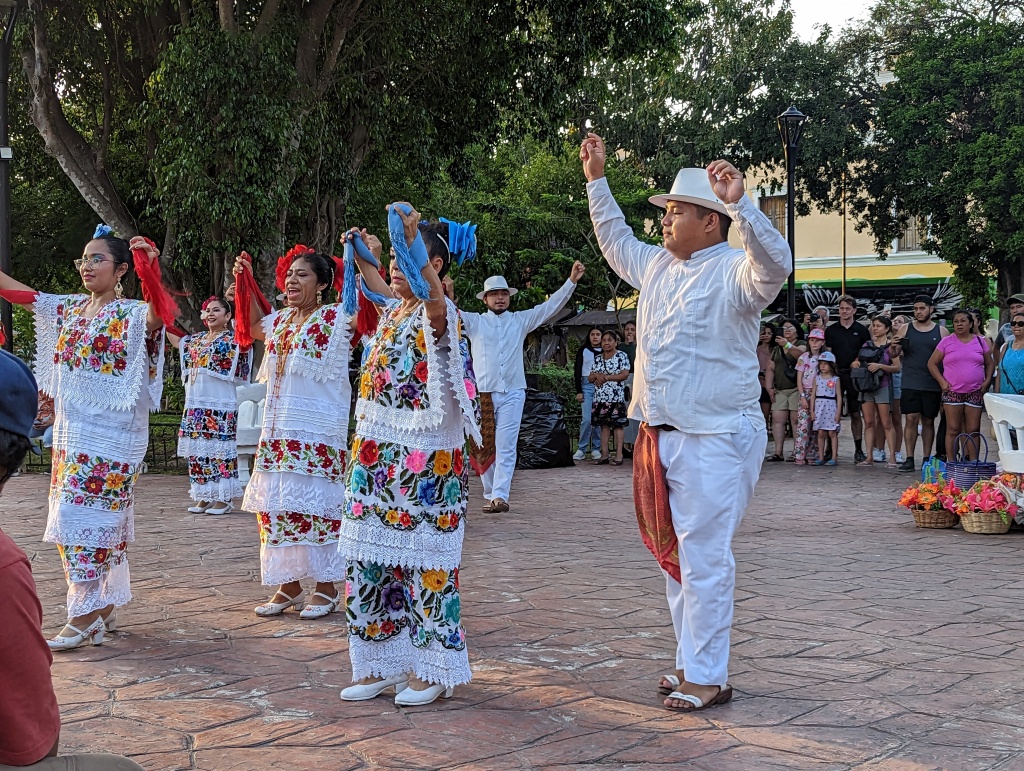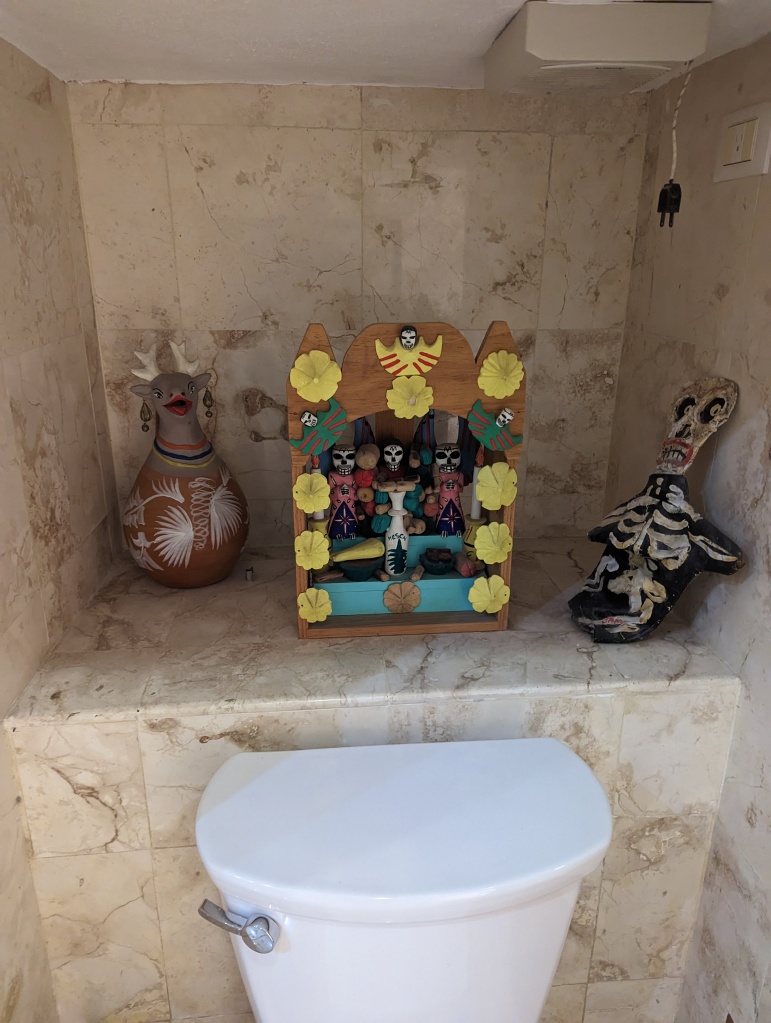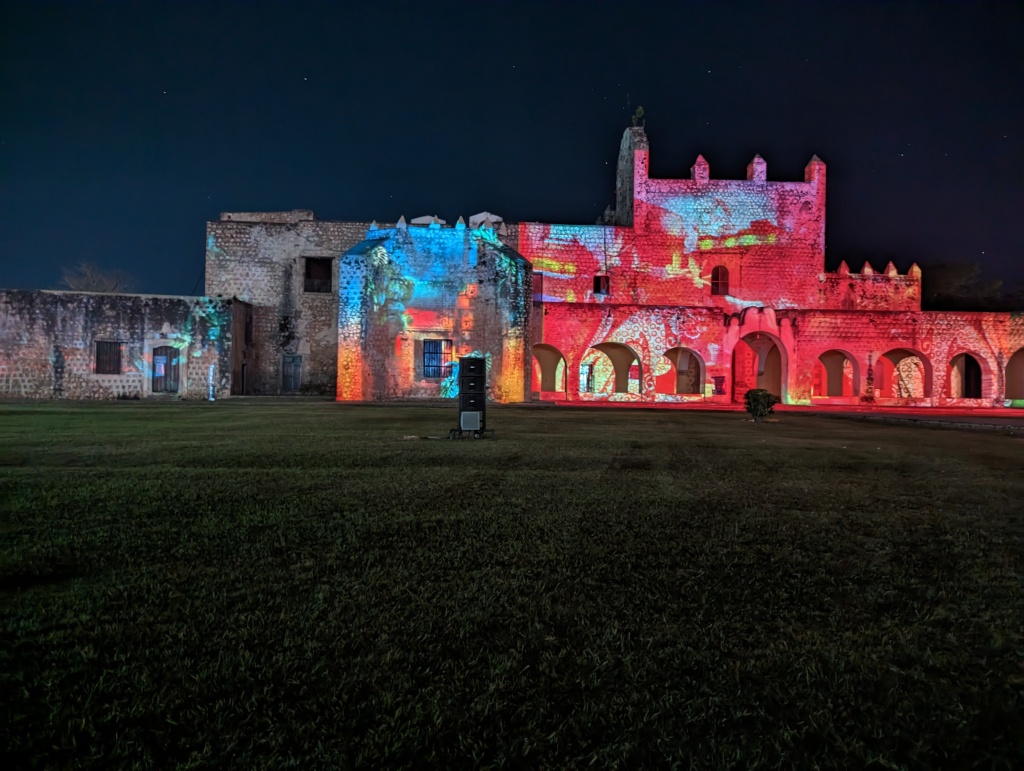Let’s dispense with the obvious first. We are not actually in Valladolid, or even Mexico, at the moment. It has just taken me a couple weeks to sit my ass down and write about our time there. If you’ve been reading this blog, or following Farrah and I on the social medias, you will already know that we are back in San Marcos la Laguna, Guatemala. But this blog post isn’t about Guatemala. It’s about Valladolid. So, let’s get on with it.
For those of you who don’t know, Valladolid is a pueblo magico in the state of Yucatan in Mexico. It is located somewhat centrally in the greater Yucatan peninsula, which is composed of three Mexican states: Yucatan, Quintana Roo and Campeche. We visited all three Yucatan states in the 3+ weeks we spent in Mexico, but we spent the majority of our time, ten days, in Valladolid.
Our time in Valladolid was somewhat marred by the fact that Farrah got a nasty case of salmonellosis, and was trapped in our tiny airbnb for about 7 days. Farrah is fully recovered, but I really can’t overstate how terrible the experience was for her. She said she had never felt more sick, and I believe it. The good news is that we went to a doctor in Valladolid, after waiting several days too long, and had a shockingly good experience. The doctor we went to was fabulous, and very attentive despite some language barrier. (My Spanish remains limited to ordering food, shopping in markets, talking about travel, and exchanging pleasantries, thankfully the doctor spoke English pretty well.) In two doctors visits we were charged only for medication, and not for the consultation itself. The total cost of 6 prescriptions was around $60 USD. I’ll let you think about what that might have cost in the US for a moment… Seriously think about it!
So, what did we do when we weren’t visiting the doctor?
Unfortunately for Farrah, most of her time was spent in our shoebox sized airbnb. I also spent a lot more time in that small space than I would have liked trying to take care of her, but when it became clear that she was going to be OK, and it was just a matter of waiting for the drugs to do their work I got out and enjoyed the city. We only had a couple of days before Farrah got sick, and we spent that mainly orienting ourselves. Although, our airbnb was very small and not a fun place to spend loads of time, it was very close to everything in the city, which made it very easy to explore. The city center was two blocks away, and we got to watch some very cool dancers there on one of our first nights.

One of my first excursions on my own was to Casa de los Venados, or house of the deer. This is a remarkable old mansion half a block off the main square. It was purchased nearly 50 years ago by an American couple who have lived there for over 40 years now. This couple are collectors of Mexican “folk art”, and sometime ago they were convinced to open their home (they still live there) to the public for viewings of their collection. They have even established a foundation to inherit the house and their collection upon their deaths. The collection contains over 3000 pieces of art, and it is stunning to say the least. Tours are given 3 or 4 times per day, and the only charge is a suggested donation of 100 pesos, which amounts to about $5 USD. I can easily imagine paying 5 times that to have the opportunity to view this amazing art. The collection takes up space in every room of the house. Although, the tour only gives guests access to select locations out of respect for the elderly owners privacy. I’ve included a photo below of some art sitting behind a toilet as evidence that the collection is quite literally everywhere in the house. For more images check out my instagram posts. Farrah also made it to Casa de los Venados when she was feeling a bit better and I was off visiting Chichen Itza, but more about that later.

On another day, after lying around the house for much of the day hoping Farrah would feel better I went out for the night time light show at San Bernadino Convent (I actually saw the show twice, as we went together on our last night in town. It was well worth seeing twice.) This light show, which is shown every night in Spanish (9p) and English (9:30p) is displayed on the walls of the convent, which in and of itself was really cool, since the structure provided depth to the display. The show displayed a brief of the history of Valladolid, originally called Zaci by the Mayan people who lived there before the Spanish showed up. As you might expect the focus of the show was on the parts of Valladolid’s history that involved the convent, which was destroyed and rebuilt, at least, 5 times by my count. I tried to keep count both times I saw the show and the only thing I know for sure is that living near the convent would have provided work for a family of stone masons for centuries.

Several days later, I took a trip to possibly the most famous ruins in the Mayan world: Chichen Itza. If you haven’t seen pictures of the Temple of Kukulcan, then I suspect you have been living under a rock for your entire life. I mean, it’s one of the seven wonders of the world. The site is one that holds special meaning to me because my mom as a young anthropology student visited Chichen Itza, and climbed the Temple of Kukulcan, when that was still possible. I grew up hearing stories about her time in Mexico, and this in part sparked my life long interest in ancient civilizations and their peoples. My trip to Chichen Itza was somewhat less magical than my mom’s. Today, Chichen Itza is a giant open air market packed with tourists and vendors hocking souvenirs. You cannot walk anywhere in the site without encountering someone trying to sell you a jaguar call, t-shirt, jewelry, or any other number of keepsakes. You also can’t climb, or touch, hardly any of the structures. Despite this it was an amazing place to see. The ball court at Chichen Itza is the largest of its kind in the Mayan world. Think of an over-sized football field with the rings (which look like basketball hoops turned sideways) positioned over 30 or 40 feet up in the air. It’s so big that no one is really sure how the game was played here since what little is known about it has suggested that players could only use their bodies between elbow and knee to hit the heavy rubber balls up towards the rings. The Temple of Kukulcan is also unbelievable to see. I wanted to climb it very badly even though I know I wouldn’t be allowed. Given the popularity of the site it is also incredibly well preserved, and discoveries at the site continue to this day. Getting to and from the site was both easy and cheap. I took an early colectivo (shared van) for about $4 USD round trip. The drive was about 45 minutes, and while the colectivos vary in comfort, for a short trip you cannot beat the price. A regular bus would have been 2 to 3 times the price, and a taxi would be closer to $40 USD one way. I don’t know for sure, but a guided tour including a bus would likely cost one person $150 USD at the very least.

Much of the rest of my time in Valladolid was spent wandering the city, which is really quite beautiful, eating street food. Yeah. I know, it’s weird that Farrah got food poisoning, while I ate street food daily with impunity. Mexican street food is fucking incredible. It costs next to nothing in American terms, and I found it to be universally delicious. My personal favorites were tamales, which I ate for lunch most days, and tortas de cochinita pibil, which instantly became my favorite thing to eat from our time in Mexico. For those who are unfamiliar, tamales are a corn “burrito” stuffed with beans and meat, or sometimes cheese. They are cooked in banana leaves, and are best eaten with hot sauce, in my opinion. Cochinita Pibil is a traditional dish of the Yucatan, and it’s basically barbecue suckling pig. If you ever visit Valladolid you really need to go to Carrito de Cochinita Pibil a food cart, which serves nothing other than cochinita pibil in your choice of torta, taco, or volcanoes (a kind of mini tamale cut open and stuffed with the goodness). The line of locals, and lucky tourists who have discovered it is generally 10 minutes long. It will take you longer to get your food than to eat it. I can’t wait to eat more Mexican street food on our next visit. This was truly a highlight for me, and I feel sad for the folks who can’t, or won’t, partake in this amazing culinary experience.
Our last day in town we finally made it to a cenote! A five minute walk from our airbnb was cenote zaci, which is literally located in the center of Valladolid. The cenote is a very deep swimming hole (hundreds of feet, or more?) that was somehow carved out of the limestone plate, which is the Yucatan peninsula. There are hundreds of these swimming holes around the Yucatan, and Mexico in general. The setting was beautiful, and the water was a very nice cool respite from the heat of the day (spoiler: the Yucatan is hot AF). The only downsides I can think of are that there really wasn’t a lot of space to hang out other than in the water, and I lost one of my earrings jumping off the cliff there. To be fair the second downside was definitely on me, and not a negative of the cenote itself.
I can say without reservation that I would personally love to return to Valladolid. The city is beautiful, the people were wonderful, there is a lot to do within a reasonably short distance, and the food was astonishingly delicious.
Hasta luego Valladolid!